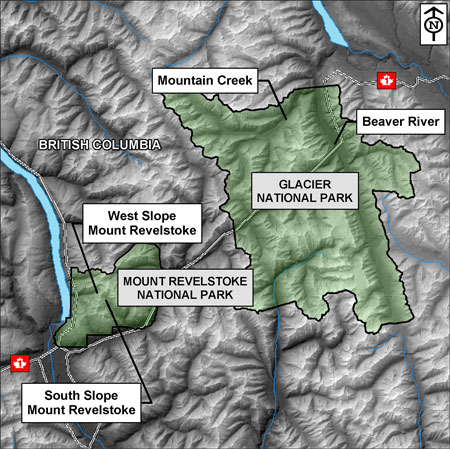Mount Revelstoke and Glacier National Park
 |
Mount Revelstoke and Glacier National Park – At risk?
 |
Mount Revelstoke and Glacier quick facts:
- Mount Revelstoke and Glacier do not have large continuous pine stands like Waterton and Banff.
- Outbreaks have been limited by the number of pine.
- In 1995, MPB outbreak activity peaked at 65 hectares in Glacier National Park.
- Areas with scattered patches of pine that have been affected by MPB include Mountain Creek (behind Mt. Rogers), Beaver River (from the northern park boundary to the Mt. Sir Donald area) and the west and south aspect slopes of Mt. Revelstoke.
British Columbia is currently experiencing a mountain pine beetle outbreak spanning 10 million hectares – an area over 60 times the size of Mt. Revelstoke and Glacier National Parks. Will Mount Revelstoke and Glacier National parks experience these types of outbreaks? The answer is in the trees. In contrast to parks like Waterton and Banff, the majority of Mount Revelstoke and Glacier is made up of Engelmann spruce and Subalpine fir at higher elevations, with interior cedar and hemlock in the valley bottoms. These forests contain only small patches of mountain pine beetle host trees – lodgepole and white pine. Seldom do mountain pine beetle populations in these types of stands develop into significant outbreaks, as there aren’t enough pine hosts to sustain a population.
In the relatively small patches of pine stands, mountain pine beetle activity in Mount Revelstoke and Glacier peaked in the mid 90’s, when the amount of trees colonized and killed reached approximately 65 hectares in 1995. Since then, mountain pine beetle colonization of high elevation lodgepole pine and whitebark pine has continued to persist. The trees are generally highly stressed due to disease and old age, and therefore susceptible to beetle attack. However, weather conditions in the park usually limit beetle reproduction. In the shorter and cooler summers characteristic of Mount Revelstoke and Glacier, mountain pine beetle broods will often require two years to mature, exposing them to additional predation and over-winter mortality.
At lower elevations, pockets of mature white pine are responsible for maintaining mountain pine beetle populations by hosting exceptionally large broods. Beetle activity is expected to continue as a result. Beetle colonization and the disease white pine blister rust will continue to have a significant effect on white pine.
Whitebark Pine
Although there are very few whitebark pine in Mount Revelstoke and Glacier, the combination of mountain pine beetle and white pine blister rust may have a significant effect on whether or not they survive. Parks Canada is compiling background information for a federal status report on whitebark pine.
- Date modified :